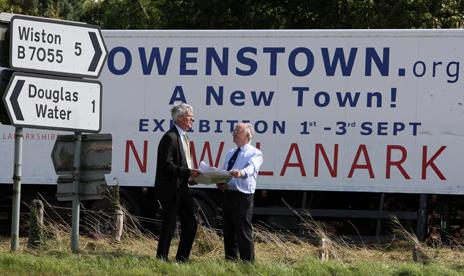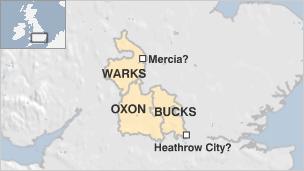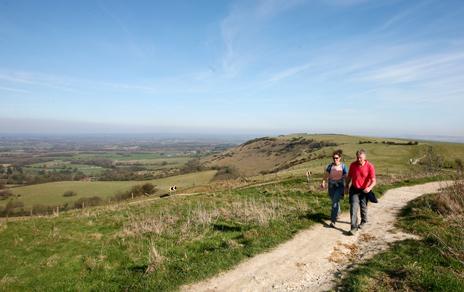Wanted: A new 'garden city'
- Published

A major competition is asking for a design for a new "garden city" for the UK. But what might it look like and where could it go?
The UK has a housing shortage. But any plans for bold new projects are often met head-on by outraged residents who feel their local area is already overbuilt.
In an attempt to counter the trend, the Charles Wolfson Charitable Trust is to award a prize of £250,000, external for the best plan to deliver a new "garden city".
The concept is not new. Letchworth - Britain's first garden city - was built over a century ago, in line with Ebenezer Howard's utopian vision. Out of the grime of 19th Century Victorian Britain, he wanted to build high quality homes arranged around village greens.
Replete with lush green open spaces, Letchworth's 33,000 people are encircled by a 13-mile country path, allowing residents to amble on an endless loop without straying far from civilisation.
Any new garden city would need to differ from Letchworth in a number of ways, however.
For a start, it would have fewer cars, says architect Alison Brooks. Referring to the new post-war towns like Milton Keynes and Stevenage, she says that "one of the flaws in the vision was that they were based on private car ownership". She argues for a clever mix of public transport, car-sharing, and cycling at the heart of any new development.
Density would need to be central to a new garden city - about 60 homes per hectare - double that of Letchworth. "We need to think about medium-height buildings," says Fabiano Lemes, who teaches urban design at the University of Portsmouth. Pushing people closer together would make walking more realistic, and needn't feel claustrophobic, he says. Balconies and terraces could replace individual gardens, roofs could become gardens themselves, and apartments could be arranged around communal parks.
Brooks's new development at Newhall Be in Essex saved space by building clusters of square houses - as opposed to rows of terraced houses - and she believes the idea could provide a blueprint for a new garden city.
Not everyone agrees that new cities should be planned at all, however. "We've been making cities for centuries, but it's only for the last 100 or so years that we've seen the need to plan them from the top down," says Dan Blott, of Portsmouth University. He cites a major new development at Almere in the Netherlands where it is hoped that a return to a more organic approach will reap rewards for its residents.

The Dutch new town of Almere
"They're proposing that a vast area of the new town will be constructed along the lines of self-build," he says. The new development has no blueprint, and instead the authorities foresee up to 60,000 new houses being built in steady response to demand.
Former mayor of Letchworth, Philip Ross, thinks that the essence of a new garden city is not about elaborate architecture. "If you go back to the original garden city, it was more of a social project than an urban planning project," he says.
Much of Letchworth is still owned collectively by its residents as opposed to absentee landlords, he explains. By holding most of the commercial buildings in a special trust, its residents benefit by leasing them out to shopkeepers. "It has assets of over £127m, and can invest £7m a year into the local economy," he says.
The principle of common ownership means its citizens share in the spoils of rising land values which are likely to continue over the coming years.

Plans for Owenstown were unveiled for 2009
Detailed plans have been drawn up for a new development to be run on similar lines in Lanarkshire, Scotland. Owenstown - named after social pioneer Robert Owen - is intended to be an eco-friendly town containing 3,000 new homes. Some would be rented out by a trust, with the profits being reinvested in the new community. Although plans were first unveiled in 2008, however, planning permission has still not been granted.
However a new town or city might be owned, its first problem will lie in finding an acceptable location.
Proximity to London is a major factor. The South East and London in particular has the most severe housing shortage. But there's an obstacle to a new city, and to development more generally, says Jack Pringle, a former president of the Royal Institute of British Architects. "Not only is the South East congested but it's also full of Nimbys. Nobody is going to want it."
Some planners even privately talk of a Nimby frontier - with the line running between Bristol and Hull. In crude terms, they characterise everywhere north of the line as being pro-development because residents think primarily in terms of jobs. South of the line people are primarily concerned with protecting their area against development.
Peter Hall, professor or urban regeneration and planning at UCL, favours a cluster of new towns just north of the line. This "Mercia" development around Rugby, Northampton and Kettering, would still allow residents to commute to London.
The issue of location is so fraught that the Town and Country Planning Association, a key proponent of new garden cities, refuses to make any suggestions at all.

Sites suggested for new cities in southern England
At the beginning of the year Nick Clegg went as far as to name three counties - Buckinghamshire, Warwickshire and Oxfordshire - as potential locations. And in 2012 David Cameron gave his support to the "principles of garden cities" in new schemes, but is yet to specify where they might go - presumably for fear of alienating voters.
Blott is so frustrated with opposition to new building schemes that he even suggests creating a new city in the South Downs. "It might sound facetious, but maybe the best place for a garden city is in the last part of the South East that you would think about building it - in a National Park or a designated area of outstanding natural beauty," he says.
Brooks thinks that building on new green field land is wasteful when there are so many existing urban and suburban areas - brown field sites - that are readily available. "You could provide millions of homes on the outskirts of every British city without building a new garden city," she says, though a debate still rages about whether such sites could meet the growing housing need.
For some, the ongoing conversation about garden cities has become outdated - the result of a dearth of new ideas.

South Downs: Would you build a city here?
Alastair Donald is a director at the Future Cities Project, a group that aims to challenge our aversion to risk in urban development. "It suggests a lack of ideas about the future to go back to an idea that's 100 years old."
"50 years ago we had all these fantastic ideas about how we could move around - jetpacks, flying cars, and all sorts of ambitious ideas. Today it seems that we've lost that scale of ambition to create something radically new," he says.
Readers gave their suggestions for the location of a new city on Facebook, external and on Twitter, external.